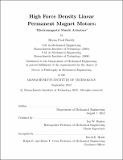High force density linear permanent magnet motors : "electromagnetic muscle actuators"
Author(s)
Ruddy, Bryan P. (Bryan Paul), 1983-
DownloadFull printable version (15.47Mb)
Alternative title
Electromagnetic muscle actuators
Other Contributors
Massachusetts Institute of Technology. Dept. of Mechanical Engineering.
Advisor
Ian W. Hunter.
Terms of use
Metadata
Show full item recordAbstract
Actuator performance represents a key constraint on the capability of many engineered devices. Performance of these devices is often exceeded by their muscle-powered natural counterparts, inspiring the development of new, "active material" actuators. This thesis reconsiders a traditional actuator, the linear permanent magnet motor, as a form of active material actuator, and presents new, unified scaling and magnetic field models for its performance. This active material motor model predicts that motors composed of large numbers of very small, actively-cooled repeat units, similar to the architecture of biological muscles, can provide greatly enhanced force density over extant designs. Our model is constructed by considering the motor winding as an active material, with its performance limited by the diffusion of waste heat. This allows a quantitative scaling model for the motor constant and force-to-mass ratio to be built for the case of a winding immersed in a homogeneous magnetic field. This model is then modified with a small set of dimensionless parameters to describe the performance penalties imposed by the use of practical sources of magnetic field, specifically periodic arrays of permanent magnets. We explain how to calculate these parameters for a variety of different types of magnet arrays using analytical magnetic field and heat transfer models, and present a new field model for tubular linear motors having improved numerical stability and accuracy. We illustrate the use of our modeling approach with two design case studies, a motor for flapping-wing flying and an actuator for high-performance controllable needle-free jet injection. We then validate our predictions by building and testing a novel water-cooled motor using a tubular double-sided Halbach array of magnets, with a mass of 185 g, a stroke of 16 mm, and a magnetic repeat length of 14.5 mm. This motor generates a continuous force density of 140 N/kg, and has a motor constant of nearly 6 N/[square root]W, both higher than any previously reported motor in this size class.
Description
Thesis (Ph. D.)--Massachusetts Institute of Technology, Dept. of Mechanical Engineering, 2012. Cataloged from PDF version of thesis. Includes bibliographical references (p. 181-194).
Date issued
2012Department
Massachusetts Institute of Technology. Department of Mechanical EngineeringPublisher
Massachusetts Institute of Technology
Keywords
Mechanical Engineering.